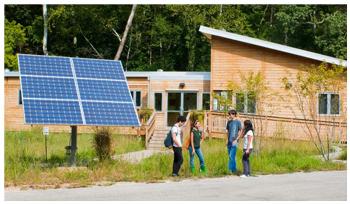Oct 13 2010
The Living Building Challenge, widely regarded as the world’s most rigorous green building performance standard, has redefined the design and construction process for more than seventy projects since its launch in 2006. The International Living Building Institute announced the results of its first third-party certification audits today, declaring that the world’s first ‘Living Buildings’ are finally a reality.
The Omega Center for Sustainable Living in Rhinebeck, NY, and the Tyson Living Learning Center in Eureka, MO, each earned full certification, or ‘Living’ status. Additionally, Eco-Sense, a private residence in Victoria, BC, earned partial program certification, ‘Petal Recognition’, for achieving four of the six stringent ‘Petals’ included in version 1.3 of the Living Building Challenge. Together, the accomplishments of these three projects mark a pivotal turning point in the green building movement, proving that buildings can be designed and built to benefit the ecosystems they inhabit.
“The Living Building Challenge calls for a fundamental shift in how we conceive of the built environment,” said Jason F. McLennan, CEO of the International Living Building Institute. “These three projects have demonstrated that we have all of the skills and technology we need to completely transform the built environment. These are quite simply the greenest buildings in the world. If the building industry follows the example set by these pioneering teams, we can begin healing our ecosystems and creating a future in which all life can thrive.”
 Tyson Research Center
Tyson Research Center
To achieve ‘Living’ status, all program requirements must be met and proven through a full year of operation. A Living Building must generate all of its own energy through clean, renewable resources; capture and treat its own water through ecologically sound techniques; incorporate only nontoxic, appropriately sourced materials; and operate efficiently and for maximum beauty. Project teams may alternatively receive Petal Recognition when they meet a minimum of three category requirements.
For the projects involved, this process has been anything but business as usual:
- The Omega Center for Sustainable Living serves as a wastewater processing plant for Omega’s 195-acre campus in the Hudson Valley. It is also a functioning classroom and yoga studio, cutting to the heart of popular conceptions about how we treat our most precious resources. “Omega is thrilled to have crossed the finish line, and hopeful that projects like ours will mark a new era in sustainable design, one that reflects a truly integrated approach to creating built environments that are in harmony with the natural world,” said Skip Backus, Chief Executive Officer at Omega. This project was designed by BNIM Architects of Kansas City, Missouri.
- For the Tyson Research Center, Washington University’s satellite campus for environmental research and education, the Living Building Challenge offered a chance to create a classroom facility that doubled as an educational tool. The experience changed everyone involved. "One of the most rewarding aspects of receiving Living Building Certification is that it formally recognizes the exceptional commitment it took to complete this project,” said Kevin G. Smith, Associate Director, Tyson Research Center. “From design and construction through over 16 months of commissioning and performance monitoring, achieving this goal required the full dedication of everyone involved in the project. I'm very proud of our team and the University for having accomplished this." Hellmuth + Bicknese Architects, of Maplewood, Missouri, designed the center.
- Ann and Gord Baird began work on Eco-Sense with a clear mission: to create a truly sustainable and affordable multi-generational home for their family. What began as a building project quickly became something much more, including regular tours and extensive media attention. “The building of our home has lead to an unexpected synergistic creation of communities,” said Ann Baird. “The telling of a new story and the real life example set by Eco-Sense has inspired many others to build in similar ways or to incorporate aspects of Eco-Sense into their existing homes.” Eco-Sense has earned Petal Recognition for Site, Water, Health and Beauty. The remaining two Living Building Challenge Petals are Energy and Materials. (A seventh Petal, Equity was added to version 2.0, released in November 2009.)
Globally, projects are now actively pursuing the Living Building Challenge – each of which promises to provide a new model of super-efficient, healthy, water-independent and net-zero energy building in its jurisdiction. These projects range from classrooms to office buildings and from community centers to private residences.
Source: http://www.ilbi.org/